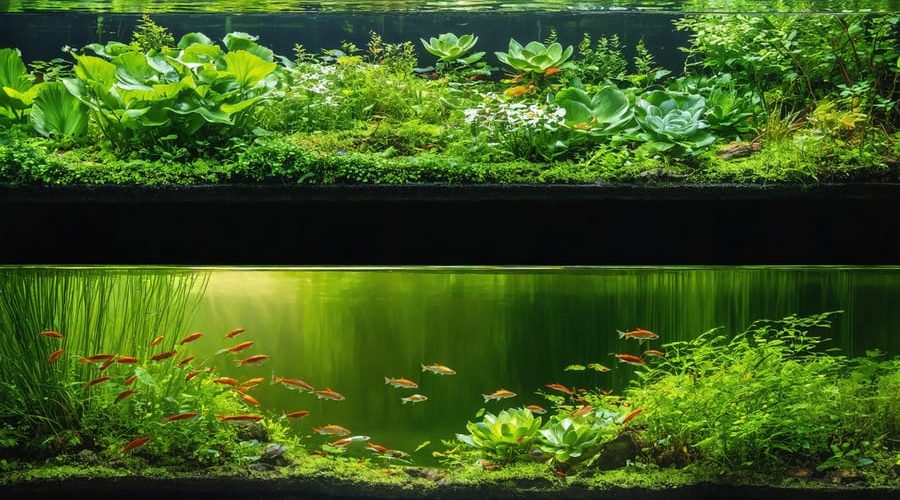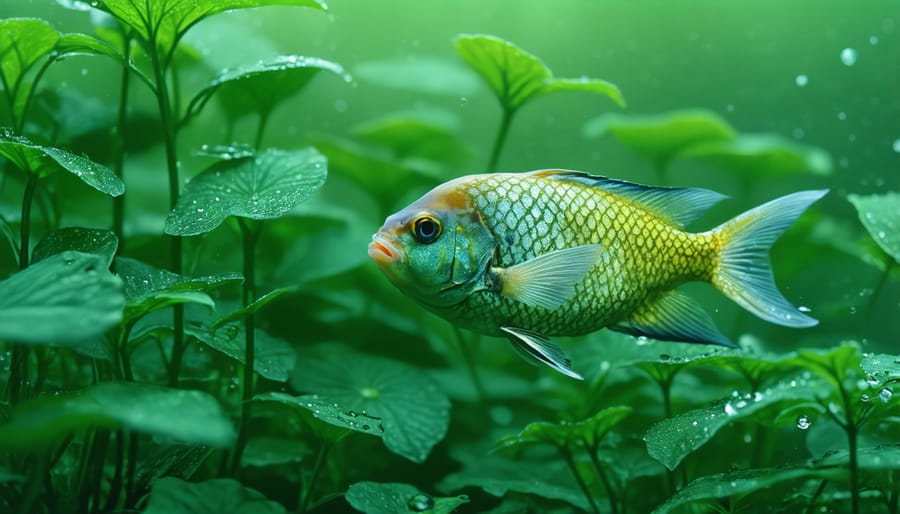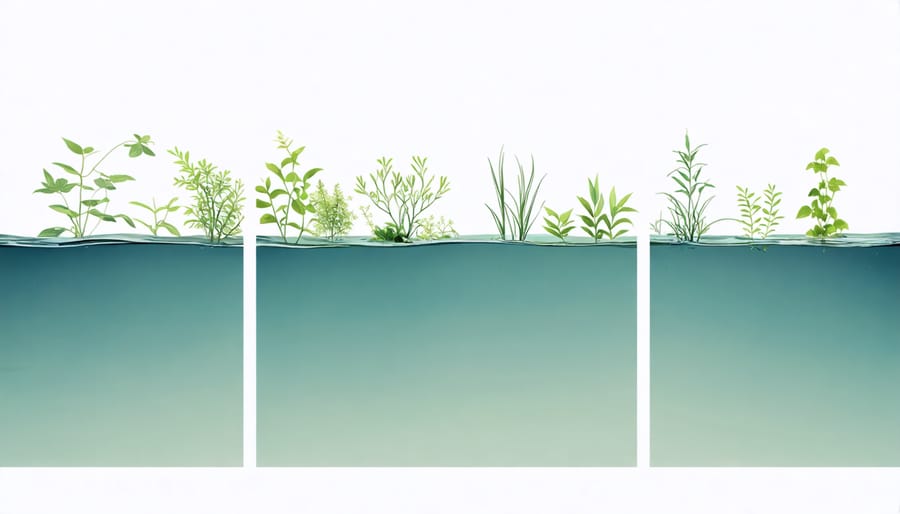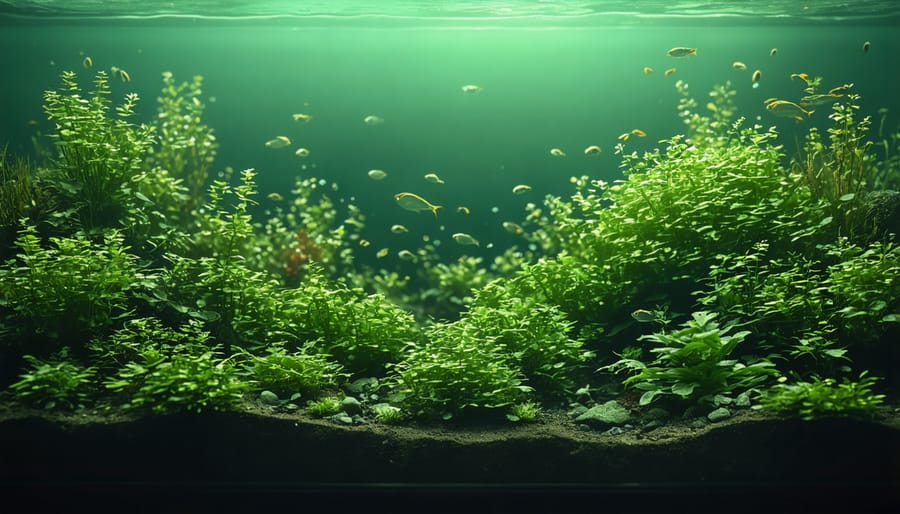
Transform Your Pond with These Beautiful Underwater Plants (Perfect for Every Depth)
Transform your pond ecosystem into a thriving underwater garden with carefully selected submerged plants. These hidden heroes of water gardens do far more than simply look beautiful – they oxygenate water, provide shelter for fish, and naturally filter harmful nutrients that could otherwise fuel algae growth.
From the deep-dwelling Anacharis that thrives in cooler waters to the adaptable Hornwort perfect for varying depths, underwater pond plants create distinct layers of aquatic life that mirror natural waterways. Whether you’re establishing a new water feature or enhancing an existing pond, these submersed plants form the foundation of a self-sustaining aquatic environment.
Choose your underwater plants based on your pond’s specific conditions – depth, sunlight, and water temperature play crucial roles in their success. Start with hardy varieties like Elodea or Vallisneria to establish your subsurface garden, then expand your collection as you gain confidence in maintaining these fascinating aquatic specimens.
Why Your Pond Needs Underwater Plants
Natural Water Purification
Underwater pond plants are nature’s own water filtration system, working tirelessly to maintain crystal-clear water in your pond. These aquatic wonders act like tiny water treatment plants, absorbing excess nutrients, particularly nitrates and phosphates, that could otherwise fuel unwanted algae growth. As they grow, they compete with algae for these nutrients, naturally helping to keep your pond water clean and clear.
Through their natural processes, submerged plants release oxygen into the water during photosynthesis, creating a healthier environment for fish and other aquatic life. Their dense foliage also provides valuable shelter for beneficial microorganisms that help break down organic waste. This natural filtration process can increase pond biodiversity while reducing the need for artificial filtration systems.
The roots of underwater plants also help stabilize sediment at the bottom of your pond, preventing cloudy water caused by stirred-up debris. This multifaceted approach to water purification makes underwater plants an essential component of any healthy pond ecosystem, working in harmony with other elements to maintain optimal water quality naturally.
Fish and Wildlife Benefits
Underwater pond plants play a crucial role in creating a thriving wildlife habitat for fish and other aquatic creatures. These plants provide essential shelter where small fish can hide from predators and create safe spaces for spawning. Young fish, in particular, rely on the dense underwater foliage to protect them during their vulnerable early stages of development.
Beyond serving as a refuge, submerged plants support a healthy food chain in your pond. They become natural breeding grounds for beneficial insects, snails, and other small organisms that fish love to eat. The plant leaves also collect beneficial algae, which serves as a food source for many pond inhabitants.
Underwater plants help maintain optimal oxygen levels throughout the day, which is vital for fish health. They also compete with unwanted algae for nutrients, naturally helping to keep your pond water clear and healthy. By choosing a variety of underwater plants, you’ll create a balanced ecosystem where fish and other wildlife can truly flourish.


Best Underwater Plants for Different Pond Depths
Shallow Zone Plants (0-12 inches)
The shallow zone of your pond offers a perfect environment for a diverse range of plants that add both beauty and functionality to your water garden. This area, ranging from the pond’s edge to about 12 inches deep, is ideal for many native pond plants and decorative species.
Popular shallow water plants include iris varieties like the Japanese Iris and Yellow Flag Iris, which produce stunning blooms in spring and summer. Marsh Marigolds add cheerful yellow flowers and provide excellent coverage with their broad leaves. Water Forget-me-nots create a carpet of delicate blue flowers that spread beautifully across the water’s surface.
For structural interest, consider adding Rush or Sedge plants, which grow in attractive vertical formations and help stabilize the pond edge. Sweet Flag offers aromatic leaves and helps filter the water, while Pickerelweed produces lovely purple flower spikes that attract butterflies and bees.
When planting in the shallow zone, use heavy clay-based soil in planting baskets with a layer of gravel on top to prevent soil from clouding the water. Position plants so their crown (where the stems meet the roots) sits just above the soil level. Most shallow water plants thrive when their roots are covered by 2-6 inches of water, making them perfect for pond margins and graduated shelves.
Mid-depth Plants (12-24 inches)
Mid-depth areas of your pond offer the perfect growing conditions for a variety of stunning aquatic plants. These plants thrive in water depths between 12 and 24 inches, creating an essential transition zone between shallow marginals and deep-water species.
The hardy water lily is a star performer at this depth, producing beautiful floating leaves and eye-catching blooms throughout the summer. Available in various colors from pristine white to deep burgundy, these plants help shade the water while providing shelter for pond fish.
Pickerelweed is another excellent choice, featuring attractive heart-shaped leaves and striking purple flower spikes that rise above the water. This native plant not only adds vertical interest but also attracts beneficial pollinators to your pond.
Consider adding American pondweed, which creates dense underwater foliage that’s perfect for fish habitat. Its small, floating leaves add texture without overwhelming the pond’s surface. Cape pondweed is another fantastic option, producing delicate white flowers that seem to float just above the water’s surface.
When planting at these depths, use heavy-duty planting baskets filled with aquatic soil. Secure plants firmly and top with gravel to prevent soil from floating away. Most mid-depth plants will benefit from fertilizer tablets specifically designed for aquatic use, applied during the growing season.
Remember to space your plants appropriately, allowing room for growth while maintaining good water circulation. This depth zone is crucial for creating a balanced ecosystem in your pond.
Deep Water Plants (24+ inches)
Deep water plants are the true champions of the pond’s deepest zones, thriving in waters 24 inches or deeper. Water lilies are the stars of this category, offering stunning blooms that float on the surface while their roots anchor deep below. Hardy water lilies come in various colors, from pristine white to deep burgundy, and can survive winter in most climates.
The majestic lotus is another showstopper for deep areas, with its massive leaves rising above the water’s surface and exotic flowers that become natural focal points. These plants need plenty of space, as they can spread extensively in favorable conditions.
Submerged oxygenators like Anacharis and Hornwort also flourish in deep water, creating essential habitat for fish while helping maintain water quality. These plants grow in thick masses and can reach impressive lengths, making them perfect for larger ponds.
When planting in deep water, use heavy-duty planting baskets with adequate soil and gravel top dressing to keep everything in place. Most deep water plants benefit from being gradually lowered to their final depth over several weeks, allowing them to adjust to the pressure and light conditions.
Remember that deep water plants typically require less maintenance than shallow water varieties, but they’ll need periodic dividing and fertilizing to maintain their vigor and beauty. Their substantial root systems help stabilize the pond bottom and provide valuable filtration benefits.
Planting and Care Tips
Planting Techniques
Installing underwater pond plants properly ensures their successful growth and establishment. Start by selecting the right planting containers – mesh baskets work best as they allow good water flow while containing the soil. Fill your basket about two-thirds full with aquatic planting soil, avoiding regular garden soil which can cloud the water.
Gently remove your plant from its nursery pot and separate any tangled roots. Position the plant in the center of the basket, spreading the roots outward. Add more aquatic soil around the roots until they’re completely covered, leaving about an inch of space at the top of the basket.
Top the soil with a 1-inch layer of small gravel or pebbles to prevent soil from floating away. This layer also helps anchor the plant and discourages fish from digging in the substrate.
For deep-water plants, attach a string or rope to your basket if you need to adjust the depth later. Slowly lower the planted basket into your pond at the appropriate depth for your specific plant variety. Most underwater plants thrive at depths between 1 and 4 feet.
If you’re planting directly in natural pond bottom, dig a small hole, place the plant’s roots in it, and cover with existing substrate. For better success rates, start new plants in spring or early summer when water temperatures are warming up.
Remember to space plants appropriately – about one plant per square foot for most varieties – to allow room for growth and proper water circulation.

Seasonal Maintenance
Keeping your underwater pond plants healthy requires attention throughout the changing seasons. In spring, start by removing any dead foliage and dividing overgrown plants before new growth begins. This is also the perfect time to add fertilizer tablets to the planting baskets, giving your plants a nutrient boost for the growing season.
During summer, regularly check for and remove any algae that might compete with your plants for nutrients. Trim back fast-growing species to prevent them from taking over your pond, and remove yellowing or decaying leaves to maintain water quality. Keep an eye on water levels, as evaporation can affect plant health during hot weather.
As autumn approaches, reduce feeding and start removing dying foliage before it can sink and decompose. For tropical varieties, consider moving them to deeper water or bringing them indoors before the first frost. Hardy species can remain in place but may need pruning to prevent debris accumulation.
Winter maintenance is minimal, but crucial. Trim back dead plant material and ensure ice doesn’t completely seal the pond surface, as this can trap harmful gases. If you have floating plants, move them to the deepest part of the pond to prevent freezing damage. Consider using a pond net to catch falling leaves before they sink and decay.
Throughout the year, monitor plant growth and adjust depths as needed, watching for signs of stress like yellowing leaves or stunted growth. Quick attention to these issues will help maintain a healthy underwater garden year-round.
Common Mistakes to Avoid
When maintaining underwater pond plants, several common mistakes can hinder their growth and impact your pond’s ecosystem. Being aware of these pitfalls will help you create a thriving aquatic garden.
One frequent error is overcrowding plants, which leads to competition for nutrients and reduced growth. Always follow spacing guidelines and remember that underwater plants will spread over time. It’s better to start with fewer plants and add more as needed.
Many pond owners make the mistake of planting at incorrect depths. Each species has specific depth requirements, and placing them too deep or too shallow can prevent proper growth. Always research the optimal depth range for each plant variety and use appropriate planting baskets or weights to maintain their position.
Another common mistake is neglecting to properly anchor plants. Floating fragments can clog filters and create maintenance headaches. Ensure plants are securely weighted or planted in appropriate containers with aquatic soil and gravel top dressing.
Poor timing during planting season is also problematic. While it’s tempting to add plants year-round, most underwater varieties establish best when planted during spring or early summer. This gives them time to develop strong root systems before winter.
Many enthusiasts overlook the importance of proper fertilization. Unlike terrestrial plants, underwater varieties need specially formulated aquatic fertilizers. However, over-fertilizing can lead to algae blooms, so always follow dosage instructions carefully.
Failing to maintain proper water quality is another crucial mistake. Regular testing and maintenance of pH levels, along with monitoring for excessive nutrients, will help prevent issues that can harm your underwater plants.
Lastly, don’t forget about seasonal maintenance. Leaving dead plant material to decompose in your pond can affect water quality and oxygen levels. Regular pruning and removal of dying foliage will keep your underwater garden healthy and vibrant throughout the year.
Creating your own underwater garden with pond plants is a rewarding and exciting journey that can transform your water feature into a thriving ecosystem. As we’ve explored throughout this guide, underwater plants not only enhance the visual appeal of your pond but also play crucial roles in maintaining water quality, supporting aquatic life, and creating a balanced environment.
Remember that successful underwater gardening starts with choosing the right plants for your pond’s depth and conditions. Whether you opt for oxygenating plants like Hornwort, striking specimens like Water Lilies, or a combination of different varieties, each plant contributes its unique benefits to your aquatic paradise.
Don’t be afraid to experiment with different plant combinations while keeping maintenance requirements in mind. Start small, and gradually expand your collection as you gain confidence and experience. Regular monitoring and seasonal care will ensure your underwater garden continues to flourish throughout the year.
By incorporating underwater plants into your pond, you’re not just creating a beautiful water feature – you’re establishing a living, breathing ecosystem that will bring joy and tranquility to your outdoor space for years to come. So gather your supplies, plan your layout, and dive into the wonderful world of underwater pond gardening. Your perfect aquatic oasis awaits!
